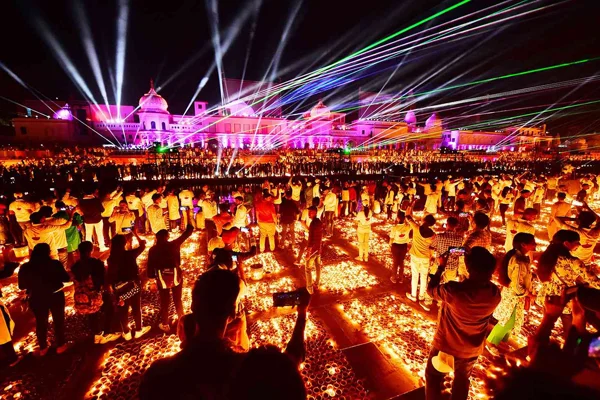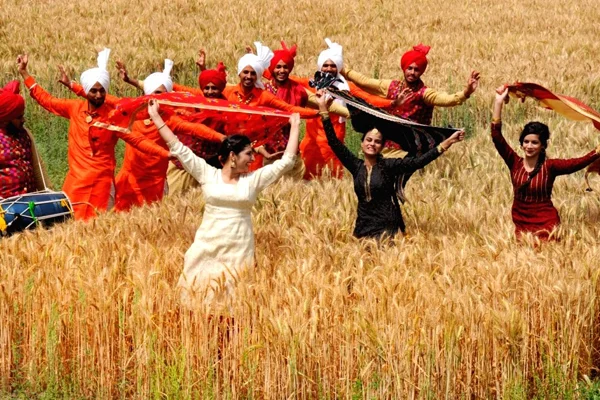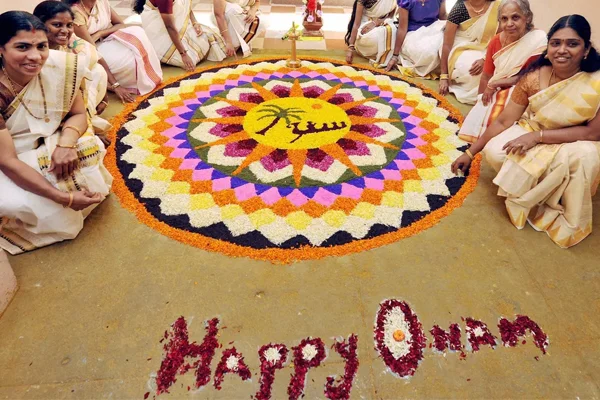Festivals in India
India is well known for various good reasons and got the name like Yoga capital of World and land of largest democracy similarly it is also known as the “Land of Festivals”. You can see people celebrating festivals all around the year. So if you just plan to visit India to celebrate and take part in the festival, then we guess you are not going back. With every festival holding its own history, significance, traditions, methods and importance you can just enjoy, dance, sing, pray, and taste the festival foods that changes from festival to festival and even state to state.
In India, people celebrate countless festivals, Oh stop! Don’t start counting, it's more than 365, yes we celebrate the number of festivals more than the number of days. People celebrate almost everything like the weather change, growing crops, harvesting crops, getting together anything. Here they enjoy life, not just the festival.
Importance of Festivals in India
Indian festivals are an essential part of the country’s fabric, showcasing its diversity and heritage and are loved for many reasons- they provide a platform for everyone to come together, beyond region and religion, as seen during Diwali when Hindus, Sikhs, Jains and Buddhists come together to light lamps and burst crackers, showcasing the unity in diversity of India. Many festivals are based on historical events and legends, giving a peek into India’s rich past, like Dussehra which commemorates the victory of Lord Rama over Ravana, symbolising the victory of good over evil.
Festivals give a huge boost to the economy, with the Diwali season alone seeing an additional $50 billion of economic activity, with people spending on new clothes, gifts, decorations and sweets. They bring a sense of community and belonging, as families come together, friends meet and communities celebrate together, with the practice of Zakat (charity) during Eid-ul-Fitr ensuring even the underprivileged join in the celebrations, promoting social equality and compassion and they give everyone a break from the daily routine, allowing people to recharge their minds and spirits through reflection, prayer and gratitude and overall well being. If you are planning to experience Indian festival and indulge in its vibrancy check out our India Tour Package.
Top 10 Festivals in India

Diwali (Festival of Lights)
Everyone knows that Diwali is the most celebrated festival of India which is also referred as the Deepavali. This signifies the victory of good over evil and light over darkness. North Indians believe that on this day Lord Ram returned back to his home after defeating evil king Ravana and completing his exile of 14 years. Early on Diwali, households are lit up using oil lamps (diyas) as well as decorated using complex rangoli patterns. Lakshmi Puja is held in homes where families come together in order to seek blessings for wealth as well as happiness. The festive season is characterized by the noise from fireworks and sweet smells from delicacies such as ladoos and barfis. You can have the site of the entire country lit up in celebration.

Holi (The Festival of Colors)
Holi is the second most celebrated festival in India. This festival also signifies the triumph of good over evil. The celebration starts on the eve of Holi, when people burn a huge bonfire ( demoness Holika) while they sing and dance. On the day of Holi, they throw different colours powder or coloured water at each other. Without any discrimination and without getting offended people enjoy, sing, dance, eat sweets like gujiya or pancake and drink Thandai (milk and spice based drink). You can’t miss this vibrant, carefree and joyous experience of this festival. Enjoy this festive season with our specially designed Holi Tour Package that will give you the best experience

Navratri and Dussehra
Navratri is a Hindu festival celebrated for nine days. During this period people offer their worship to Durga, the goddess that kills demons known as Mahishasura. Every night during navratri is celebrated with dance performances like Garba and Dandiya which are lively dances often loved by many people in Gujarat as well as other parts of India. In September the festivity commences, while October sees its closure with a grand Dussehra signifying Rama’s triumph against Ravana the demon king. Huge statues of effigies symbolizing Ravana are burnt after dark on Vijayadasami night which marks Dussehra.

Ganesh Chaturthi
The festival of Ganesh Chaturthi is a ten-day celebration of Lord Ganesha's birth, this elephant-headed god is worshipped as the god of wisdom, prosperity and good fortune. Usually this falls between August and September. The festival starts with the installation of Lord Ganesha idols of clay and Plaster of Paris in homes and outdoor pandals (tents). It is celebrated by the people of all faiths and religions. On the last day also known as Anant Chaturdashi thousands of people take these idols and immerse them into water with songs and dances.

Eid-ul-Fitr
The end of Ramadan, which is the sacred month of fasting for Islamic people, is indicated by Eid-ul-Fitr. Salat al-Eid is held specially for this occasion in mosques as part of a day. Everyone comes together on this day as families to share a sumptuous meal complete with various types of foods such as kebab, Biryani, or sweet like sheer khurma make the favorite meals especially for this ceremony. Compassionate and community-oriented acts that include Zakat (charity) are performed as an integral part of this day. It is a time for you to experience the warmth and hospitality of India's Muslim communities

Pongal
In mid-January, there is a significant harvest festival mainly celebrated in Tamil Nadu, known as Pongal. This festival, named after a traditional dish made of new rice, milk, and jaggery. Pongal lasts for a total of four days. Kolam (rangoli) decorations in houses, sun god worship as well as boiling the first rice of a season are among activities during this period. It will offer you a rural experience, traditional roots and traditional south Indian culture.

Baisakhi
Celebrated on April 13th or 14th, Baisakhi is an important holiday for Sikhs and represents the Punjabi new year. It was instituted in 1699 to mark the formation of the Khalsa by Guru Gobind Singh, the tenth Guru of Sikhs. although it is also celebrated as a harvest season for the rabi crops. It is marked with vibrant fairs as well as traditional dances such as Bhangra or Gidda in addition to community feasts. By attending the Baisakhi celebration, it will provide you an insight into sikh culture and lifestyle of Punjab.

Onam
Onam, the harvest festival of Kerala, falls usually in August or September. Onam commemorates the coming back of the mythical King Mahabali. This ten-day festival features elaborate feasts known as Onam Sadhya that contain 20 dishes that are served on banana leaves whereas the other highlights of this festival are Vallam Kali (snake boat races), Pookalam (floral decorations) and traditional dances like Kathakali. Visitors can indulge into Kerala’s rich traditions and its lush natural beauty.

Christmas
Christmas is widely celebrated in India, especially in areas with a huge number of Christians - Goa, Kerala, North East India but not limited to these areas. It is widely popular all over India. Walls of the churches shine with electric lights and are decorated nicely. Not only the churches you can see every house, malls, shops, schools are decorated with attractive glitters and Christmas trees. People offer prayers to Jesus Christ, exchange gifts, organise feast with family and friends and treat with special plum cakes.

Makar Sankranti
This is a nation wide festival but is known by different names and is celebrated in different rituals everywhere, this is also a harvest festival celebrated usually on 14th or 15th of january where you can see colourful kites all over the sky fighting with each other, bonfire and people serving traditional sweet made made of sesame and jaggery. It is believed that taking an early dip bath in Ganga river in this cold weather wash away all your sines. For you, it is an opportunity to witness regional diversity and participate in celebrations.
List of Other Famous Festivals in India
- Lohri
- Republic Day
- Mahashivratri
- Good Friday
- Rama Navami
- Mahavir Jayanti
- Buddha Purnima
- Id-ul-Zuha (Bakrid)
- Independence Day
- Ganesh Chaturthi
- Janmashtami
- Raksha Bandhan
- Chhath Puja
- Bhai Dooj
- Dhanteras
- Basant Panchmi
- Rath Yatra
- Karva Chauth
- Kali Puja
- Guru Nanak Jayanti
Biggest Festival in India
Every festival has its own value, significance and is celebrated with the full hearted but if you consider the number of people taking part in all these festivals then Diwali and Holi is the biggest and most celebrated festival in India. Even considering the number of international tourists visiting India for the festival are highest during these two festivals. Because they are being celebrated transcending all boundaries either it is religion, regional, or national. All streets, homes, businesses create a spectacular display of lights on Diwali and are painted with various colors on Holi. You will see people exchanging sweets, gifts, hugging and expressing heartfelt wishes with each other. With our Car Rental in India, you can now explore these biggest festival in any state of Indian Territory.
Festival Foods in India
There is not a single festival in India without a great variety of food to gorge on. Here we have some must-try festival foods:
Diwali: Sweet desserts including ladoos, barfis, gujiyas, Kheer (rice pudding) and salty snacks like samosas and kachoris.
Holi: Gujiya (a type of sweet dumplings), bhang thandai (special milk-based drink), and different kinds of sweets like kind of pancake.
Navratri: Sabudana khichdi, kuttu puri, and an array of mouth-watering fruit-based meals that are suitable for fasting during the day.
Ganesh Chaturthi: Modaks (dumplings made with sweet ingredients) and puran poli (a special flatbread).
Eid-ul-Fitr: Sheer khurma (a sweet milk and vermicelli dish), biryani, and kebabs.
Pongal: Pongal, the traditional dish from the harvesting of new rice, jaggery, and milk.
Baisakhi: Makki di roti (cornbread) and sarson da saag (mustard greens).
Onam: Sadya, which is served on banana leaves, includes rice, an aromatic vegetable stew, avial, and payasam, traditional sweets.
Christmas: Plum cakes, roasted meat, and sweet dishes are some of the wonderful delicacies that are to be enjoyed.
Makar Sankranti: The main Tilgul sweet made of purified sesame seeds and jaggery is a common maxim of this Indian festival. Not only the Gujaratis but the other regions such as south and west, also prepare pongal and puran poli.
Popular Tour Destinations
Faq for Festivals in India
The Hornbill Festival is in the Northeastern Indian state of Nagaland. It is an annual festival celebrated from 1 to 10 December. The festival pays tribute to Hornbill for its qualities of alertness and grandeur by the Nagas.
Generally Holi is celebrated in the month of march but the date keeps changing as it follows the Hindu calendar, according to this calendar it falls on the full moon day of the month of Falgun. In the year 2025, Holi is lying on 14th March.
Bastar Dussehra is considered as the world's longest festival, which is celebrated for around 75 days. This is celebrated at the Danteswari temple of Jagadalpur in Bastar district, Chhattisgarh, India. The worship is offered to a log of saal tree as a tradition of over 600 years.




